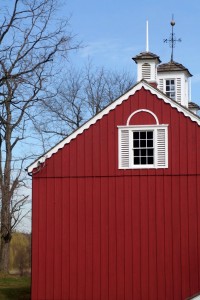 I spent a few hours wandering around some nearby farmland that was purchased in the last few years to become part of the county park system. I’ve only been there once before and today it was just as deserted as on my prior visit. There’s no soccer fields or playground here, so it tends to be very quiet but for a few runners or dog walkers.
I spent a few hours wandering around some nearby farmland that was purchased in the last few years to become part of the county park system. I’ve only been there once before and today it was just as deserted as on my prior visit. There’s no soccer fields or playground here, so it tends to be very quiet but for a few runners or dog walkers.
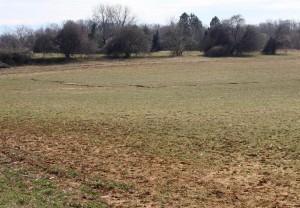 There is a small wooded hillside on the property that was bursting with trilling juncos today. The remainder of the area is farm fields, some of which are leased out to grow corn mostly. It’s a good spot to visit in summer for butterflies. Today when I stepped out from the woods to the edge of the field above I immediately heard insects humming and saw thousands of these flying about low over the field.
There is a small wooded hillside on the property that was bursting with trilling juncos today. The remainder of the area is farm fields, some of which are leased out to grow corn mostly. It’s a good spot to visit in summer for butterflies. Today when I stepped out from the woods to the edge of the field above I immediately heard insects humming and saw thousands of these flying about low over the field.
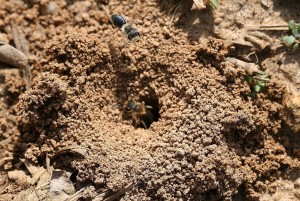 I have no idea what they are, but they look like some sort of bee. The fields edges were covered with holes that looked like anthills, and when I got close enough for photos I saw the bees going in and out of the holes.
I have no idea what they are, but they look like some sort of bee. The fields edges were covered with holes that looked like anthills, and when I got close enough for photos I saw the bees going in and out of the holes.
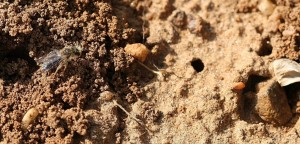 They weren’t at all concerned with me. Thank goodness because there were lots of them. Anyone have any ideas? I haven’t looked in any of my insect guides yet, but doubt I’ll have much luck sorting these out.
They weren’t at all concerned with me. Thank goodness because there were lots of them. Anyone have any ideas? I haven’t looked in any of my insect guides yet, but doubt I’ll have much luck sorting these out.
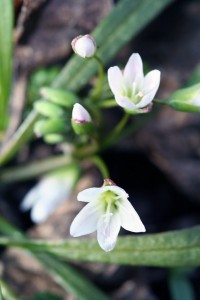 At the edge of the property is a small brook that one can walk along for a few miles. Most of the land that this brook runs through is protected as a *greenway* and it connects a few different county parks that I visit. I thought I might be able to find some wildflowers blooming so I walked in the wet woods along the brook for a ways and found these blooming – I think they’re spring beauties?
At the edge of the property is a small brook that one can walk along for a few miles. Most of the land that this brook runs through is protected as a *greenway* and it connects a few different county parks that I visit. I thought I might be able to find some wildflowers blooming so I walked in the wet woods along the brook for a ways and found these blooming – I think they’re spring beauties?
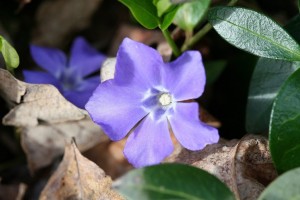 I found great patches of periwinkle in the shady woods. At least, that’s what I think it is. It reminds me of the vinca that people plant beneath large trees in their yards, so these pretty purple flowers must be escapees invading the woodlands.
I found great patches of periwinkle in the shady woods. At least, that’s what I think it is. It reminds me of the vinca that people plant beneath large trees in their yards, so these pretty purple flowers must be escapees invading the woodlands.
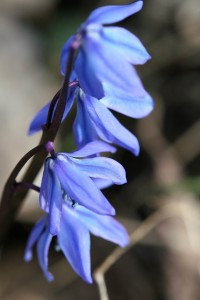 I also found many patches of these beautiful purple flowers, but haven’t been able to sort out what they are. I took lots of *artsy* photos, but none to help with ID. Maybe someone will recognize it anyway.
I also found many patches of these beautiful purple flowers, but haven’t been able to sort out what they are. I took lots of *artsy* photos, but none to help with ID. Maybe someone will recognize it anyway.I could have walked for hours today, but worried about running out of light on the walk back to my car. I didn’t see another person until the very end of my walk, when I came across a group of very muddy kids with their mom, sifting for shark’s teeth and other fossils in the brook. Looked like fun, but a bit too chilly for me! It was just nice to see kids out doing such a thing, and it reminded me of something we might have dreamed up to do as kids on an early spring day.
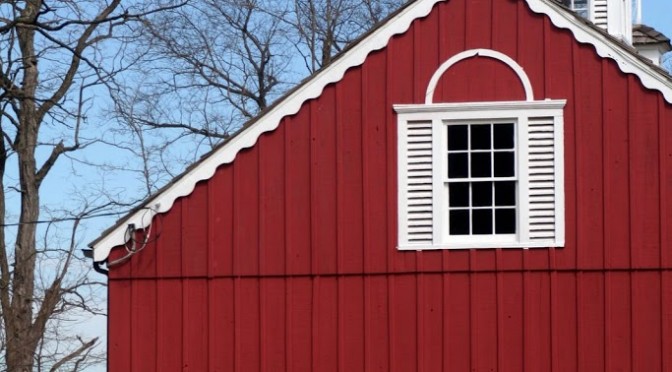
A brook close by that you can wonder along for miles? Oh my! That’s just wonderful.
Could the last picture be Squill?
I think you’re right, Cathy. The flowers were very shy and kept their backs to me. Another escapee, I guess.
It’s great to read that someone has the vision to preserve places like this and actually create a greenway. Those can be vital for wildlife movement. Isn’t NJ our most densely populated state? It’s so good to hear there are so many natural areas there.
Thanks for taking us on your walk with you.
Thanks, Laura. I’d love to walk with you and notice those little treasures you photographed. Gosh, you are good with the close-ups. I’m not good at flowers and plants, or even birds, for that matter, so I can’t help with IDs.
Those bees are interesting. I know hornets have ground nests but I’ve never seen one to look like an ant hill. Speaking of ants, we have fire ants down here and I’ve seen a few on campus. I hope I don’t see them at my house!
Beautiful pictures and story, as usual.
What a tonic Spring can be!
I am not an insect expert. When I first saw the picture, I thought of ant lions.
I’m no help on the flowers, either.
I’m fairly useless, aren’t I?
Very nice images.I know that you can upload photos and get an i.d. on insects at birdforum.-
I don’t know my flowers-I just know that they are nice to look at.-
I can’t wait for a vacation so I can spend the whole day in an area like this.I hate time limitations.
i love the title of this post…and the best part is that i really feel like i was with you. you are surrounded by much beauty. the best part is that you NOTICE it!
It looks like a beautiful place to wander. I really need to get out and get some “nature” on me! Thanks for the great tour.
What a lovely day and lovlier images…
Nice post, and respite from the usual self-promoting blog. Posted similar pictures a few days ago, but my camera isn’t as accomplished at macro photography.
Thanks for taking us along – it looks like a nice place. Have no clue on the bees – not up on my insect id. Glad they weren’t concerned with your presence!
Yes, thanks for inviting us. It looks like a place with lots of promise. Hooray for that mom getting muddy with her kids in the great outdoors.
Laura, your photographs are like poems. What a wonderful walk. Thanks for sharing!
Scilla for that last one. I love that blue. A non-native.
Periwinkle is an invader, and can crowd out the natives. A good job for the local scouts would be a ‘cleanup day’ to pull it out if it’s getting to think in there.
That was a nice walk even though I was a day late.
What a wonderful walk. I love the first photo of the bright red barn.
That is definitely periwinkle and Jenn is right that it is invasive, or at least indestructible.
I planted it on a slopping bank next to our pool. I am very careful to keep chopping it back and so far it is staying put. It makes great ground cover.
What y’all call periwinkle I’ve always called myrtle, and yes, it is very agressive – it’s taking over my front lawn. I have a sentimental attachment to it, though, because my grandmother planted it here.
Laura! Thanks so much for the ‘Crocus’ poem you left in my comments. It’s just wonderful.
I believe your bees are some species of Adrena (often called Mining Bees). There are quite a number of species. They make branching tunnels in the ground and females lay their eggs at the end of each branch. Some species share the same entrances to tunnel systems. Here are some links to photos and text about them.
http://www.uri.edu/ce/factsheets/sheets/miningbees.html
http://www.kendall-bioresearch.co.uk/solbee.htm#mining
http://www.gardensafari.net/english/mining_bees.htm
Mojoman: Yes, I think it’s true about NJ being the most densely populated; I think my county has one of the best park systems in the state though.
This area, in particular, has a problem with access. There is almost no parking and often the road is blocked; almost as if they don’t want anyone to visit. Maybe that’s for the best.
Mary: Fire ants? Are they as awful as I’ve read?
Susan: Maybe but we’ll keep you around for your raptor ID skills.
but we’ll keep you around for your raptor ID skills.
Larry: IMO, life is too short to wait for a vacation! I try to find an hour or two where I can to make up for the time lost at work.
Jessie: Thanks, yea – it’s fun to look for little things though.
Laurie: Yes! Get some nature on you! lol!
Jayne: I had fun, thanks.
Dr. Know: Thanks for coming by. Your pics were nice too!
Laura: There were thousands, I think and kooky me was right in the middle taking pics. I read in some book though that bees respond to a person’s good thoughts, so I just kept thinking loving thoughts towards them so they wouldn’t sting.
Bev says they’re solitary bees which aren’t prone to sting – lucky for me, I guess.
FC: They were muddy and wet and looked happy!
Liza: Thanks for coming along with me!
Jenn: Yes, thanks!
When my DH and I were first married and with our new house we bought a few flats of vinca and promptly killed all of it! Can you imagine? Some angel was looking out for us there, I think.
Dave: A day late doesn’t matter! Any signs of spring your way?
KGMom: Yea, we killed it somehow here. I think I might like to plant some squill bulbs, though – they’re very pretty!
Dave: It is very pretty I think, reason enough to let it go in place of grass. And that your grandma planted it, well – let it be for her.
Cathy: Wasn’t that a fun one?
Bev: Thanks for coming by to help me out! I wonder if these bees were making nests and mating so early in the season, or if the numbers that I saw were hatching? Neat to see anyway!
Laura – I just added some more notes on my blog to answer your question about the bees, but decided to come over here and leave an answer as well in case you didn’t see the other. I’m quite sure that Adrena would overwinter as adults in your area (in refuges underground) and emerge very early in the spring to begin collecting tree pollen to stock their underground egg chambers where eggs would be laid. You also mentioned insect field guides. Audubon is okay as a starting point. There’s a new guide out that I haven’t seen yet — It goes by the name Kaufman Field Guide to Insects of North America, by Eric Eaton. Cindy Mead wrote a little about it a week or so ago. Apparently, I have a few photos in it (I haven’t received my copy yet). It’s supposed to be quite good. The other book I’d recomment, but this is only if you’re starting to get serious about insects, is Stephen Marshall’s tome “Insects: Their Natural History and Diversity — with a photographic guide to insects of eastern North America.” It’s good but a bit costly, and definitely not a book you would lug along with you on a field trip! (-: